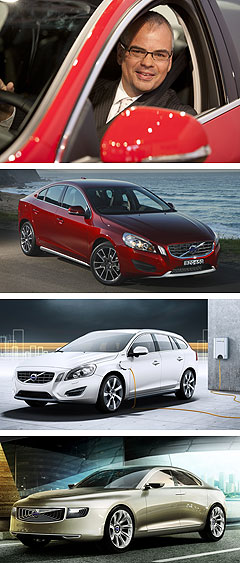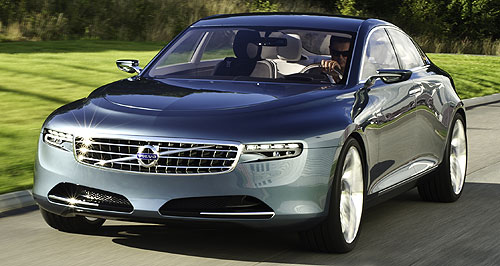News - VolvoNew product to transform Volvo: JacobyNext-gen: The next Volvo S80, previewed by the Concept You at the Frankurt show last month, may be badged S90 due to its larger size. Vast future product program, continued profitability underscore Volvo’s road ahead11 Oct 2011 By BYRON MATHIOUDAKIS in SWEDEN VOLVO Car Corporation president and CEO Stefan Jacoby admits it will take up to three years before the Swedish car-maker settles into its post-Ford state of independence, and a further two years for the first phase of its new-model strategy to be fully realised in the marketplace. This is despite a “very successful” first year of operation under the ownership of Zhejiang Geely Holding Group of China, which has seen Volvo deliver a better-than-expected $US1 billion dollar profit in 2010, a further healthy profit forecast for 2011, a drastic increase in operating efficiencies and a strong start for the relatively new S60 and V60 model ranges. Speaking to Australian media at the company’s Gothenburg headquarters this week, Mr Jacoby revealed the transition period from Ford control last August had commenced more smoothly than anticipated, with an unprecedented level of independence for the Swedish manufacturer. “We need time. It is a long-cycle investment,” Mr Jacoby said. “The decisions I make today will not come to life before 2015. This is how our industry is. “And I say we would need a further two to three years before we are truly stable, and for the renewal of our product range we will need maybe another five years until we really have in the market what we want, and what we want to do in the future.” Emphasising that Chinese ownership does not mean an end of independent design and engineering for Volvo – comments which echo those made when Geely sealed the $US1.8 billion deal with Ford in August last year – Mr Jacoby added that there will be no Geely interference or influence on the future product portfolio.  Left: Volvo Car Corporation president and CEO Stefan Jacoby. Below: S60 T4, V60 Plug-in Hybrid, Concept Universe. Left: Volvo Car Corporation president and CEO Stefan Jacoby. Below: S60 T4, V60 Plug-in Hybrid, Concept Universe.These will include the 2014 replacement for the ageing XC90 seven-seater luxury SUV, which has still proved useful for Volvo nearly a decade on from launch, with global sales up four per cent this year. Debuting the company’s all-new and in-house-developed ‘scalable platform architecture’ (SPA), the redesigned XC90 will also sire the successor to the S80 flagship that may be known as the S90 owing to its larger overall size. It is said to share visual similarities to the well received Concept Universe and Concept You show cars at this year’s respective Shanghai and Frankfurt motor expos. Other SPA recipients will be the replacements for today’s V70 and XC70 (2014) as well as the next-generation XC60, S60 and V60 models set for launch in the latter half of this decade. Volvo is also working on a third-generation C70 coupe/convertible expected in about 2014, which has been confirmed as a project in the pipeline by Mr Jacoby this week, after production of the five-year-old current model co-devised with Pininfarina ceases at the Uddevalla plant in Sweden. Whether that model is twinned or based on the replacement for the 2006-era C30 due at around the same time is unknown. Before that, however, one of the last Ford-era projects will surface at next March’s Geneva motor show in the guise of the so-called ‘C40’ hatch. To supplement rather than replace the current C30, the C40 will arm Volvo with a serious weapon against the Volkswagen Golf, BMW 1 Series, Audi A3 and Mercedes A/B-class segments in the form of a proper five-seater and five-door premium hatch. The latter will eventually take over from the eight-year-old S40/V50 models in the Swedish brand’s line-up, hitting “the sweet spot” against its German rivals in a way that its slightly out-of-step size-wise predecessors have been unable to. Similarly, entry-level versions of the existing S60/V60 will be positioned to create a more natural step up from top-end C40 iterations. Volvo is also believed to be working on a C40 XC ‘Cross Country’ version, in the vein of the Subaru Impreza XV all-wheel-drive version, while a rebodied and more SUV-like XC40 wagon is expected to target the new Audi Q3 and BMW X1 when it comes on stream in 2013, after a possible Paris motor show debut next September. To help differentiate the beefed-up wagons from the more dedicated SUVs in the line-up, the XC ‘Cross Country’ badge is expected to return after a decade-long hiatus, when the second-generation V70 XC was replaced by the identical XC70 during 2001. According to Mr Jacoby, each of these vehicles will be designed, developed and engineered in Sweden by Volvo, and will not share technology of any description with Geely vehicles. All will aim to lead their respective segments for electrification, safety, design and feel, as Volvo seeks to “concentrate on its strengths” in the luxury car sphere using ‘Swedishness’ as a major drawcard against its mostly German competitors. Plus, as GoAuto reported earlier this year, the entire Volvo model line-up from about 2014 will adopt four- and even three-cylinder powerplants. Available in both petrol and diesel configurations, and mostly with partial electrification and/or forced induction, to significantly cut emissions and consumption while boosting performance, power outputs will range from around 110kW to approximately 230kW, to match and exceed today’s engines. Furthermore, the higher-performance R-line and Polestar models will up the performance ante by up to 30 per cent above that, giving the ultimate future go-faster Volvos power figures in the region of about 260kW, according to one insider. “This is the first year of independence from the Ford Motor Company – and the transition has gone extremely well,” Mr Jacoby said. “We didn’t lose any car manufacturing, we didn’t lose any engineering, and we didn’t lose any suppliers over this period. “It took 10 to 12 months to spin Volvo off … now we are an independent company with a totally different set-up. “Under Ford we were part of a bigger company we are now stand-alone that offers a lot of opportunity that makes change necessary. “Next to that we have managed to significantly improve profitability – to the tune of US$1 billion compared to 2009 we have launched two very successful models – the S60 and V60 – and they have been very well received in all markets … and we are running to maximum capacity. “We will continue to be profitable through 2011 and growing in all markets… and on top of that we have developed a complete strategy that defines all areas of our business. “It has required lots of changes from what we have done in the past and what we need to do now.” Before the wave of all-new models outlined above hits in Australia, minor model-year facelifts of the existing XC90, XC70 and V70 are scheduled early in 2012. Volvo Car Australia is also investigating the production version of the V60 Plug-in Hybrid diesel also due out in Europe next year it was an Australian International Motor Show highlight in Melbourne back in July. Volvo’s five-year model plan forecast:XC90, XC70, V70 facelift: Q1 2012V60 Plug-In Hybrid: 2012 C40: Q1 2013 C40 XC: Q4 2013 C30 II: 2014 XC40: 2014 C70 III: 2014 XC90 II: 2014 S90: 2014 V70 IV: 2015 XC70: 2015 XC60 II: 2015 S60 III: 2016 V60 II: 2016  Read more4th of October 2011  Volvo rejigs 2012 modelsC30 coupe and XC70 SUV prices rise as Volvo slashes ageing S40 sedan and V50 wagon3rd of October 2011  Sub-50K T4, frugal D3 diesel for Volvo’s S60, V60Volvo S60, V60 get new T4 petrol, D3 diesel engines, more kit, five-year care pack14th of September 2011  Frankfurt show: Volvo reveals the real YouVolvo unveils S80 replacement with the Concept You fastback8th of September 2011  Another facelift for Volvo XC90Volvo’s ageing XC90 family SUV gets a tweak, for European markets at least8th of September 2011  Frankfurt show: Volvo firing on all fourVolvo set to debut new engine tech in mystery ‘Concept You’ at Frankfurt |
Click to shareVolvo articlesResearch Volvo Motor industry news |
















Facebook Twitter Instagram